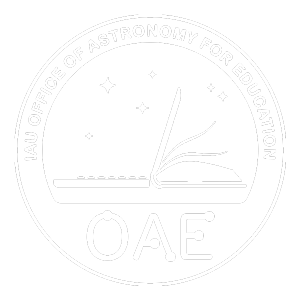This page describes an image Sky Over the Town of Nindirí, in Masaya, Nicaragua
Image caption:
Honourable mention in the 2022 IAU OAE Astrophotography Contest, category Still images of celestial patterns.
This image was taken in Tisma, Nicaragua, in April 2022 during a night illuminated by the Moon. Still, some constellations are visible, but the Milky Way, which runs through the image with some of its brightest regions, hides in the celestial background, partially obscured by terrestrial clouds.
The Scorpion, one of the constellations of the Zodiac, is seen on the left side. We can first spot the brightest star, Antares, in the middle of a group of three in an asterism that looks like the stem of a flower growing from the clouds upwards. Its petals are the head of the scorpion. In the brightness of moonlight, the orange colour of Antares is not clearly visible. The three stars that comprise the head of the scorpion are called Acrab, Dschubba and Fang. They were recently named by the IAU in order to show the global diversity of constellations. Acrab is the Arabic term for the scorpion and Fang (The Room) is the name of the Chinese constellation made out of these stars. The Scorpion’s tail extends to the bottom of the image with the sting just above the horizon in the gap between clouds.
The constellation Centaurus is visible in the middle of this image. We can first recognise Crux and the two pointer stars, Alpha and Beta Centauri right above the clouds. The pointers are the front hooves of the centaur, while the stars of Crux were originally (before Christanity, in antiquity) considered one of the rear legs of the centaur. The stars in the front hooves are Rigil Kentaurus (mixed Arabic and Latin meaning The Foot of the Centaur), to the left, and Hadar, to the right. With Crux at the rear they comprise the legs of the mythological creature’s horse body. The humanoid torso is represented by two bright stars on the shoulders and three fainter stars for the head. The star tale says that this figure represents Chiron, the only decent one among the centaurs who was well educated and the teacher of all great heroes.
The Christian navigators who sailed to the New World around 1500 used these asterisms, although they had never seen them before in Europe. These included explorer Amerigo Vespucci whose name was given to the continent America. His shipmate Andrea Corsali, who came from Florence, where the poet Dante Alighieri was famous for his Divine Comedy written two centuries earlier, was reminded of Dante's poem by the four bright stars of Crux. It was probably in this context that they happened to invent the constellation Crux. Originally, the navigators only used the asterism for practical purposes but some time later, in the period of Christian religious wars between several new churches, celestial cartographers used the cross as a symbol of unity and against war.
Scroll to captions in other languages
Image credit:
René Antonio Urroz Álvarez/IAU OAE
DOI: 10.5281/zenodo.7425594
Related glossary terms:
Alpha Centauri
, Scorpius
Categories:
Naked Eye Astronomy
Image license: Creative Commons Attribution 4.0 International (CC BY 4.0) Creative Commons Attribution 4.0 International (CC BY 4.0) icons
The media file captions presented on the OAE website were written, translated and reviewed by a collective effort from the OAE, the OAE Centers and Nodes, the OAE National Astronomy Education Coordinators (NAECs) and other volunteers. You can find a full list of credits for our translation project here. All media file captions are released under a Creative Commons CC BY-4.0 license and should be credited to "IAU OAE". The media files themselves may have different licenses (see above) and should be credited as listed above under "credit".
If you notice a factual error in this caption or an error in any of its translations then please get in touch.
Captions in Different Languages:
Image caption: Lobende Erwähnung beim IAU OAE Astrofoto-Wettbewerb 2022, Kategorie Weitwinkelaufnahmen von Himmelsmustern.
Dieses Bild wurde im April 2022 in einer vom Mond aufgehellten Nacht in Tisma in Nicaragua aufgenommen. Einige Sternbilder sind dennoch sichtbar, aber die Milchstraße, die sich mit einigen ihrer hellsten Regionen durch das Bild zieht, versteckt sich im Himmelshintergrund, teilweise verdeckt auch durch irdische Wolken.
Der Skorpion (lat. Scorpius), eines der Sternbilder des Tierkreises, befindet sich auf der linken Seite. Antares, dessen hellster Stern, befindet sich in der Mitte einer Gruppe aus drei Sternen, die wie der Stiel einer Blume aussieht, die aus den Wolken nach oben wächst. Die Blütenblätter sind der Kopf des Skorpions. Bei der Helligkeit des Mondes ist die orange Farbe von Antares nicht deutlich sichtbar. Die drei Sterne, aus denen der Kopf des Skorpions besteht, heißen Acrab, Dschubba und Fang. Sie wurden kürzlich von der IAU benannt, um die globale Vielfalt der Sternbilder zu zeigen. Acrab ist die arabische Bezeichnung für den Skorpion und Fang (der Raum) ist der Name des chinesischen Sternbilds, das aus diesen Sternen besteht. Der Schwanz des Skorpions reicht bis zum unteren Rand des Bildes, wobei der Stachel knapp über dem Horizont in der Wolkenlücke zu sehen ist.
Das Sternbild Zentaur (lat. Centaurus) ist in der Mitte des Bildes zu sehen. Leichter sind das Kreuz des Südens (lat. Crux) und die beiden Zeigersterne alpha und beta Centauri direkt über den Wolken zu erkennen. Die Zeigersterne sind die vorderen Hufe des Zentauren, während die Sterne des Kreuzes ursprünglich (vor dem Christentum, in der Antike) als eines der Hinterbeine des Zentauren angesehen wurden. Die Sterne in den vorderen Hufen sind Rigil Kentaurus (eine Mischung aus arabischer und lateinischer Bedeutung: der Fuß des Zentauren) links und Hadar rechts. Zusammen mit dem Kreuz am hinteren Ende bilden sie die Beine des Pferdekörpers des mythologischen Wesens. Der humanoide Torso wird durch zwei helle Sterne als Schultern und drei schwächere Sterne für den Kopf dargestellt. Die Mythologie besagt, dass diese Figur Chiron darstellt, den einzigen anständigen unter den Zentauren, der sehr gebildet und der Lehrer aller großen Helden war.
Die christlichen Seefahrer, die um 1500 in die Neue Welt segelten, benutzten diese Asterismen, obwohl sie sie in Europa noch nie gesehen hatten. Zu ihnen gehörte der Entdecker Amerigo Vespucci, der dem Kontinent Amerika seinen Namen gab. Sein Schiffskamerad Andrea Corsali, der aus Florenz stammte, wo der Dichter Dante Alighieri für seine zwei Jahrhunderte zuvor verfasste Göttliche Komödie berühmt war, fühlte sich durch die vier hellen Sterne des Kreuzes an Dantes Gedicht erinnert. Wahrscheinlich erfanden sie in diesem Zusammenhang zufällig das Sternbild Crux. Ursprünglich nutzten die Seefahrer den Asterismus nur für praktische Zwecke, aber einige Zeit später, in der Zeit der christlichen Religionskriege zwischen mehreren neuen Kirchen, verwendeten die Himmelskartografen das Kreuz als Symbol der Einheit und gegen den Krieg.
Image credit: René Antonio Urroz Álvarez/IAU OAE
Related glossary terms: Alpha Centauri , Skorpion Caption translation status: Not yet approved by a reviewer
Caption translators: Carolin Liefke
Image caption: Menzione d'onore al concorso di astrofotografia IAU OAE 2022, categoria Immagini fisse di modelli celesti.
Questa immagine è stata scattata a Tisma, in Nicaragua, nell'aprile 2022 durante una notte illuminata dalla Luna. Sono ancora visibili alcune costellazioni, ma la Via Lattea, che attraversa l'immagine con alcune delle sue regioni più luminose, si nasconde sullo sfondo celeste, parzialmente oscurata dalle nuvole terrestri.
Lo Scorpione, una delle costellazioni dello Zodiaco, è visibile sul lato sinistro. Possiamo innanzitutto individuare la stella più luminosa, Antares, al centro di un gruppo di tre in un asterismo che sembra lo stelo di un fiore che cresce dalle nuvole verso l'alto. I suoi petali sono la testa dello scorpione. Nella luminosità della luna, il colore arancione di Antares non è chiaramente visibile. Le tre stelle che compongono la testa dello scorpione si chiamano Acrab, Dschubba e Fang. Sono state recentemente nominate da IAU per mostrare la diversità globale delle costellazioni. Acrab è il termine arabo per lo scorpione e Fang (La stanza) è il nome della costellazione cinese composta da queste stelle. La coda dello scorpione si estende fino alla parte inferiore dell'immagine, con il pungiglione appena sopra l'orizzonte nello spazio tra le nuvole.
La costellazione del Centauro è visibile al centro della foto. Possiamo riconoscere Croce del Sud e due stelle puntatrici, Alfa e Beta Centauri, sopra le nuvole. I puntatori sono gli zoccoli anteriori del centauro, e le stelle della Croce del Sud (prima di Cristo, nell'antichità) erano considerate una delle zampe posteriori del centauro. Le stelle negli zoccoli anteriori sono Rigil e Kentaurus (misto arabo e latino che significa Il piede del centauro), a sinistra, e Hadar, a destra. Con la Croce del Sud nella parte posteriore, essi costituiscono le zampe del corpo equino della creatura mitologica. Il busto umanoide è rappresentato da due stelle luminose sulle spalle e da tre stelle più deboli per la testa. Il racconto delle stelle dice che questa figura rappresenta Chirone, l'unico decente tra i centauri, ben istruito e maestro di tutti i grandi eroi.
I navigatori cristiani che salparono verso il Nuovo Mondo intorno al 1500 utilizzarono questi asterismi, sebbene non li avessero mai visti prima in Europa. Tra questi c'era l'esploratore Amerigo Vespucci, il cui nome fu dato al continente America. Il suo compagno di bordo Andrea Corsali, che proveniva da Firenze, dove il poeta Dante Alighieri era famoso per la Divina Commedia scritta due secoli prima, si ricordò del poema dantesco per le quattro stelle luminose della Croce del Sud. Fu probabilmente in questo contesto che inventarono la costellazione della Croce del Sud. In origine, i navigatori utilizzavano l'asterismo solo per scopi pratici, ma qualche tempo dopo, nel periodo delle guerre religiose cristiane tra diverse nuove chiese, i cartografi celesti utilizzarono la croce come simbolo di unità e contro la guerra.
Image credit: René Antonio Urroz Álvarez/IAU OAE
Related glossary terms: Alfa Centauri , Scorpione Caption translation status: Approved by a reviewer
Caption translators: Giuliana Giobbi
Caption reviewers: Rodolfo Canestrari
Image caption: 2022年国际天文学联合会(IAU)OAE天文摄影比赛静态天体图案类别荣誉奖作品。
这张照片是2022年4月在尼加拉瓜蒂斯马拍摄的。尽管当时正值月夜,但一些星座依然清晰可见。银河贯穿整个画面,其最明亮的区域在天空中若隐若现,一部分被地球的云层所遮蔽。
在照片左侧可以看到天蝎座,它是黄道星座之一。我们一眼就能看到这个星座中最亮的恒星——心宿二,它位于一个由三颗恒星组成的星群中央,这个星群仿佛是从云层中向上生长的花茎,其上的花瓣便是天蝎的额头。在明亮的月光下,心宿二的橙色并不明显。组成天蝎额头的三颗恒星分别是房宿一、房宿三和房宿四,国际天文学联合会(IAU)最近规定了它们正式的英文星名,以展示星座的全球多样性。其中,房宿一被命名为Acrab,源自阿拉伯语的“蝎子”一词;房宿三被命名为Dschubba,源自阿拉伯语的“额头”一词;而房宿四被命名为Fang,源自其所属的中国二十八星宿之一——房宿。天蝎的尾巴延伸至照片底部,其毒刺恰好位于地平线上方的云层间隙之中。
在照片的中央,半人马座清晰可见。我们首先可以在云层之上辨认出南十字座以及两颗指极星——南门二(半人马座α星)和马腹一(半人马座β星)。这两颗指极星象征着半人马的前蹄,而在基督教诞生前的古代,南十字座的恒星则被认为是半人马的一条后腿。半人马前蹄左侧是南门二,英文名为Rigil Kentaurus,是阿拉伯语和拉丁语的混合,意为”半人马之足“;右侧是马腹一,英文名为Hadar,源自阿拉伯语,意为”在地面之上“。它们与南十字座共同构成了这一神话生物马身的双腿。而人形躯干则由肩部的两颗明亮恒星和头部的三颗较暗恒星组成。在星空传说中,这个形象代表的是喀戎,他是唯一一位品德高尚、学识渊博的半人马,也是所有伟大英雄的导师。
公元1500年左右,那些前往新大陆的基督教航海家们虽然从未在欧洲见过这些星群,但开始利用它们导航。其中包括探险家亚美利哥·韦斯普奇(Amerigo Vespucci),美洲大陆就是以他的名字命名的。他的同船伙伴安德烈亚·科尔萨利(Andrea Corsali)来自佛罗伦萨,著名诗人但丁·阿利吉耶里(Dante Alighieri)两个世纪之前在那里创作了《神曲》。科尔萨利看到南十字座的四颗明亮恒星时,联想到了但丁的诗篇。或许正是在这样的背景下,他们偶然间创造了南十字座。起初,航海家们只是将这一星群用于实用目的。但不久后,基督教各个新教派之间爆发了宗教战争,这一时期的天文学家们将十字形状绘制在星图上,作为团结与反战的象征。
Image credit: René Antonio Urroz Álvarez/IAU OAE
Related glossary terms: 半人马座 α , 天蝎座 Caption translation status: Not yet approved by a reviewer
Caption translators: Bao Lizhuo
Image caption: 2022年國際天文學聯合會(IAU)OAE天文攝影比賽靜態天體圖案類別榮譽獎作品。
這張照片是2022年4月在尼加拉瓜蒂斯馬拍攝的。儘管當時正值月夜,但一些星座依然清晰可見。銀河貫穿整個畫面,其最明亮的區域在天空中若隱若現,一部分被地球的雲層所遮蔽。
在照片左側可以看到天蠍座,它是黃道星座之一。我們一眼就能看到這個星座中最亮的恆星——心宿二,它位於一個由三顆恆星組成的星群中央,這個星群仿佛是從雲層中向上生長的花莖,其上的花瓣便是天蠍的額頭。在明亮的月光下,心宿二的橙色並不明顯。組成天蠍額頭的三顆恆星分別是房宿一、房宿三和房宿四,國際天文學聯合會(IAU)最近規定了它們正式的英文星名,以展示星座的全球多樣性。其中,房宿一被命名為Acrab,源自阿拉伯語的“蠍子”一詞;房宿三被命名為Dschubba,源自阿拉伯語的“額頭”一詞;而房宿四被命名為Fang,源自其所屬的中國二十八星宿之一——房宿。天蠍的尾巴延伸至照片底部,其毒刺恰好位於地平線上方的雲層間隙之中。
在照片的中央,半人馬座清晰可見。我們首先可以在雲層之上辨認出南十字座以及兩顆指極星——南門二(半人馬座α星)和馬腹一(半人馬座β星)。這兩顆指極星象徵著半人馬的前蹄,而在基督教誕生前的古代,南十字座的恆星則被認為是半人馬的一條後腿。半人馬前蹄左側是南門二,英文名為Rigil Kentaurus,是阿拉伯語和拉丁語的混合,意為”半人馬之足“;右側是馬腹一,英文名為Hadar,源自阿拉伯語,意為”在地面之上“。它們與南十字座共同構成了這一神話生物馬身的雙腿。而人形軀幹則由肩部的兩顆明亮恆星和頭部的三顆較暗恆星組成。在星空傳說中,這個形象代表的是喀戎,他是唯一一位品德高尚、學識淵博的半人馬,也是所有偉大英雄的導師。
公元1500年左右,那些前往新大陸的基督教航海家們雖然從未在歐洲見過這些星群,但開始利用它們導航。其中包括探險家亞美利哥·韋斯普奇(Amerigo Vespucci),美洲大陸就是以他的名字命名的。他的同船夥伴安德烈亞·科爾薩利(Andrea Corsali)來自佛羅倫薩,著名詩人但丁·阿利吉耶裡(Dante Alighieri)兩個世紀之前在那裡創作了《神曲》。科爾薩利看到南十字座的四顆明亮恆星時,聯想到了但丁的詩篇。或許正是在這樣的背景下,他們偶然間創造了南十字座。起初,航海家們只是將這一星群用於實用目的。但不久後,基督教各個新教派之間爆發了宗教戰爭,這一時期的天文學家們將十字形狀繪製在星圖上,作為團結與反戰的象徵。
Image credit: René Antonio Urroz Álvarez/IAU OAE
Related glossary terms: 半人馬座 α , 天蠍座 Caption translation status: Not yet approved by a reviewer
Caption translators: An automated transliteration from the simplified Chinese translation by - Bao Lizhuo









